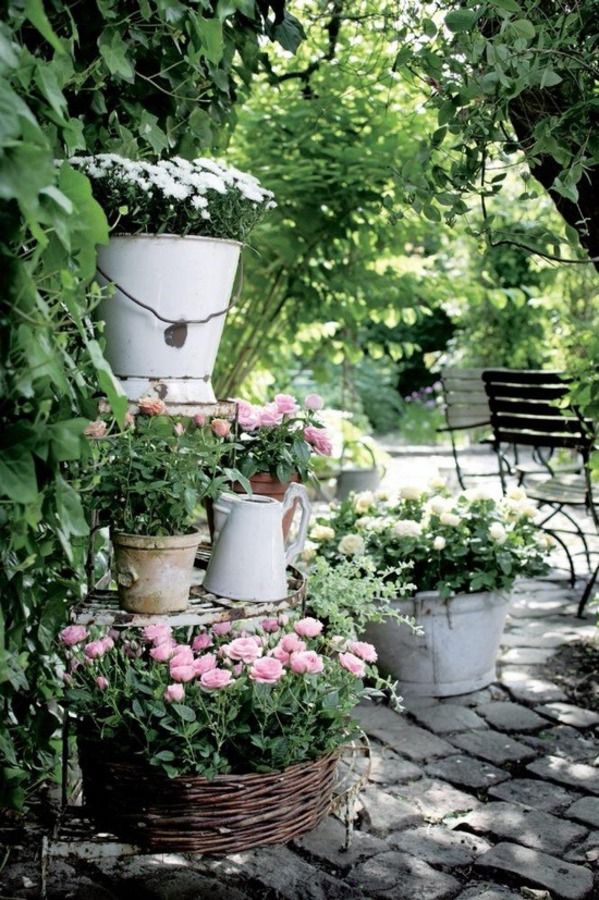Are you looking to transform your outdoor space into a thriving green oasis with simple backyard gardening ideas? Whether you are a seasoned gardener or just starting out, creating a beautiful and productive garden in your backyard can be a rewarding experience. From blooming flowers to fresh vegetables, there are countless benefits to nurturing a garden right outside your door.
Simple backyard gardening involves selecting the right plants, utilizing creative container gardening ideas, exploring vertical gardening techniques, and engaging in fun DIY projects to enhance the beauty of your outdoor space. By incorporating these elements into your gardening routine, you can enjoy the pleasures of nature right in your own backyard while reaping the rewards of your efforts.
In this article, we will delve into the world of simple backyard gardening, offering tips on plant selection, container gardening strategies for limited spaces, DIY projects to personalize your garden, natural pest control methods, watering techniques for healthy plants, maintenance tips for year-round care, and ways to harvest and enjoy the fruits of your labor. Let’s explore how you can create a flourishing oasis in your backyard with easy-to-follow ideas and practices.
Choosing the Right Plants
When it comes to simple backyard gardening ideas, one of the fundamental aspects is selecting the right plants for your garden. Choosing easy-to-grow flowers and vegetables can make a significant difference in the success and enjoyment of your gardening experience.
For beginners or those with limited time to dedicate to gardening, opting for low-maintenance plants is key. Some great options for easy-to-grow flowers include marigolds, petunias, and zinnias, which can thrive with minimal care. When it comes to vegetables, tomatoes, lettuce, and radishes are excellent choices for beginners due to their relatively undemanding nature.
Another factor to consider when selecting plants for your backyard garden is the climate and soil conditions in your area. It’s essential to choose plants that are well-suited to the specific conditions of your location to ensure they will flourish. Conducting some research on native plants or consulting with a local garden center can help you determine the best plant varieties for your region.
In addition to choosing plants that are easy to grow and suitable for your climate, consider selecting a mix of flowering plants and vegetables to create a diverse and visually appealing garden space. This variety not only adds interest but can also help attract pollinators and beneficial insects to your garden, ultimately contributing to a healthier ecosystem. By carefully selecting the right plants for your backyard garden, you can set yourself up for a successful and rewarding gardening experience.
| Easy-to-Grow Flowers | Easy Vegetables |
|---|---|
| Marigolds | Tomatoes |
| Petunias | Lettuce |
| Zinnias | Radishes |
Container Gardening
When embarking on container gardening, it’s important to choose the right containers for your plants. Make sure that the containers have drainage holes at the bottom to prevent waterlogging, which can lead to root rot. Additionally, consider the size of the container based on the mature size of the plant you intend to grow. For example, larger plants like tomatoes will need bigger pots to accommodate their roots and growth.
One creative idea for container gardening is to utilize vertical space by hanging baskets or installing shelving units for stacked planters. This not only saves ground space but also adds visual interest to your backyard garden.
Mixing different types of plants in a single container or creating a “container garden” with multiple coordinating containers can also create a stunning focal point in your outdoor space. With a little creativity and some simple backyard gardening ideas, you can transform even the smallest backyard into a lush and vibrant oasis with container gardening.
Vertical Gardening
When dealing with limited space in a small backyard, vertical gardening can be a game-changer. By growing plants upward instead of outward, you can maximize your available space and create a lush green oasis in even the smallest of outdoor areas.
There are several creative ways to implement vertical gardening, such as using trellises, hanging planters, or wall-mounted containers. These techniques not only add visual interest to your backyard but also provide more room for planting a variety of flowers, herbs, and vegetables.
One simple yet effective vertical gardening idea is to install a trellis or set up stakes for climbing plants like tomatoes, cucumbers, or beans. This not only saves ground space but also allows these plants to grow vertically, providing better air circulation and easier access for harvesting.
Another option is the use of hanging planters or baskets to suspend plants like strawberries or trailing vines from fences or pergolas. This not only adds dimension to your backyard garden but also creates an eye-catching display.
In addition to traditional pots and planters, consider repurposing items like old pallets, shoe organizers, or even gutters to create vertical plant displays. These DIY projects are not only cost-effective but also allow for customization based on your backyard’s layout and aesthetics. With some creativity and planning, vertical gardening can transform any small backyard into a vibrant and productive green space.
| Vertical Gardening Tip | Benefits |
|---|---|
| Use trellises for climbing plants | Maximizes space and provides better air circulation |
| Repurpose old pallets for vertical displays | Cost-effective and customizable |
DIY Garden Projects
Creating a DIY Garden Path
One of the easiest and most impactful DIY projects for your backyard garden is creating a garden path. Whether you choose to use stepping stones, gravel, or mulch, a well-designed path can add charm and functionality to your outdoor space. Consider adding solar-powered lights along the path for an added touch of ambiance in the evenings. This project not only enhances the aesthetics of your garden but also allows for easy access to different areas of your yard.
Building a Raised Garden Bed
Another great DIY project to consider for your backyard gardening endeavors is building a raised garden bed. This is especially beneficial if you have poor soil quality or want to control the growing conditions for specific plants. You can easily construct a raised bed using wood, bricks, or even recycled materials like old pallets.
Fill it with nutrient-rich soil and start planting your favorite flowers or vegetables. Not only does this project offer practical benefits, but it also adds dimension and visual interest to your garden.
Creating a Vertical Herb Garden
For those with limited space in their backyard, creating a vertical herb garden can be a game-changer. Utilize old wooden pallets, hanging planters, or wall-mounted containers to grow herbs like basil, parsley, mint, and more vertically.
This not only saves space but also makes it convenient to have fresh herbs within arm’s reach when cooking. Get creative with the design and placement of your vertical herb garden to add a unique and functional element to your outdoor space while enjoying the bountiful harvest of homegrown herbs throughout the season.
Pest Control
Companion Planting
One of the simplest and most natural ways to deter pests in your backyard garden is through companion planting. Certain plants have natural properties that repel insects or attract beneficial predators that feed on harmful pests. For example, planting marigolds around your tomato plants can help deter aphids, while attracting ladybugs can help control populations of aphids, mealybugs, and other harmful insects. Research companion planting combinations that work best for the types of plants you are growing in your garden.
Organic Sprays and Traps
Another effective method for controlling pests in your backyard garden is using organic sprays and traps. Homemade solutions like garlic spray, neem oil, or chili pepper spray can be used to deter common pests like aphids, caterpillars, and beetles.
Additionally, setting up traps such as beer traps for slugs or sticky traps for flying insects can help reduce pest populations without harming beneficial insects in your garden. These natural pest control methods are safe for the environment and won’t leave harmful residues on your produce.
Maintaining a Healthy Garden Ecosystem
Creating a balanced and healthy garden ecosystem is key to preventing pest problems in the first place. Make sure to provide proper sunlight, water, and nutrients to your plants to keep them strong and resilient against pests. Avoid over-fertilizing or overcrowding plants, as this can weaken their defenses against infestations.
Encouraging biodiversity by planting a variety of different species will also attract beneficial insects that help control pest populations naturally. By focusing on building a healthy and diverse garden ecosystem, you can reduce the need for chemical interventions while keeping pesky critters away from your precious plants.
Watering Tips
Watering plays a crucial role in the success of any backyard garden. Proper watering ensures that your plants receive the necessary moisture to thrive and produce vibrant blooms or bountiful harvests. One of the simplest backyard gardening ideas is to establish a regular watering routine based on the specific needs of your plants. Different plants require varying amounts of water, so it’s important to research and understand the watering requirements of each species in your garden.
To determine when and how much to water your backyard garden, consider factors such as soil type, weather conditions, and plant varieties. A general rule of thumb is to water deeply but infrequently, allowing the soil to dry out slightly between waterings to promote healthy root development. Using mulch around your plants can also help retain moisture in the soil and reduce water evaporation, especially during hot summer months.
Another effective watering technique for a backyard garden is drip irrigation. This method delivers water directly to the base of plants through a network of tubes or hoses with emitters.
Drip irrigation not only conserves water by reducing waste from runoff and evaporation but also ensures that each plant receives an adequate amount of moisture without wetting the leaves, which can lead to disease. By incorporating these simple watering tips into your backyard gardening routine, you can promote plant health, conserve water, and enjoy a thriving garden all season long.
Maintenance and Care
Maintaining and caring for your backyard garden is crucial to ensure that it thrives throughout the changing seasons. Here are some essential tips to help you keep your garden in top shape:
- Regularly check for pests and diseases: Inspect your plants regularly for any signs of pests or diseases. Taking early action can prevent serious damage to your garden.
- Prune and trim as needed: Trim back overgrown plants and prune dead or damaged branches to promote healthy growth. This also helps improve air circulation and sunlight exposure for your plants.
- Keep up with weeding: Weeds compete with your plants for nutrients and water, so it’s important to regularly pull them out to prevent them from taking over your garden.
Proper watering is essential for the health of your backyard garden. Here are some watering tips to help you maintain a thriving garden:
- Water deeply but infrequently: It’s better to water deeply a few times a week rather than shallowly every day. This encourages plant roots to grow deeper into the soil.
- Water in the morning: Watering in the morning allows plants to absorb moisture before the heat of the day evaporates it. Avoid watering in the evening, as this can promote fungal diseases.
- Use mulch: Mulching around your plants helps retain moisture in the soil, reduces weed growth, and regulates soil temperature. It also adds nutrients to the soil as it breaks down over time.
By following these maintenance and watering tips, you can ensure that your backyard garden remains healthy and flourishing throughout the seasons. With proper care and attention, you’ll be able to enjoy a bountiful harvest of homegrown produce and beautiful flowers from your simple backyard gardening efforts.
Harvesting and Enjoying
In conclusion, simple backyard gardening ideas offer a rewarding and fulfilling experience for gardeners of all levels. From choosing the right plants to creative container gardening and utilizing vertical space, there are numerous ways to make the most out of your outdoor space. By incorporating DIY garden projects, you can add a personal touch to your garden while enhancing its beauty and functionality.
When it comes to harvesting and enjoying the fruits of your labor, there are endless possibilities. Whether you are growing flowers or vegetables, fresh produce from your backyard garden can be enjoyed in various delicious recipes. From salads to stir-fries, homemade salsas to fruit jams, there are countless ways to incorporate your homegrown produce into your meals.
Furthermore, preservation methods such as canning, freezing, and drying allow you to enjoy your harvest long after the growing season is over. By following best practices for watering, maintenance, and pest control throughout the seasons, you can ensure healthy and thriving plants that will provide you with an abundance of fresh ingredients for years to come. So why not start implementing these simple backyard gardening ideas today and reap the benefits of a bountiful harvest right in your own backyard?
Frequently Asked Questions
How Do I Build a Garden in My Small Backyard?
Building a garden in a small backyard requires careful planning and creativity. Start by assessing the space you have and consider vertical gardening to maximize space. Choose plants that thrive in small areas and consider adding containers or raised beds for more planting options.
How Can I Make My Yard Look Good on a Budget?
Making your yard look good on a budget is possible with some DIY projects and smart shopping. Consider starting with basic landscaping like mowing the lawn, trimming edges, and clearing out debris. Look for affordable plants at local nurseries or consider growing from seeds. Adding mulch can also improve the overall look of your yard without breaking the bank.
How Do You Make a Simple Beautiful Garden?
Creating a simple beautiful garden involves choosing a cohesive color scheme, incorporating different textures, and focusing on minimalism. Choose a variety of plants that bloom at different times for year-round interest and consider adding pathways or focal points like a water feature or sculpture.
Remember that less is often more when it comes to design, so don’t overcrowd the space with too many elements.

Welcome to my gardening blog! I am passionate about plants and enjoy sharing my knowledge and experiences with others. In this blog, I will write about everything related to gardening, from tips on how to get started to updates on my own garden projects.





